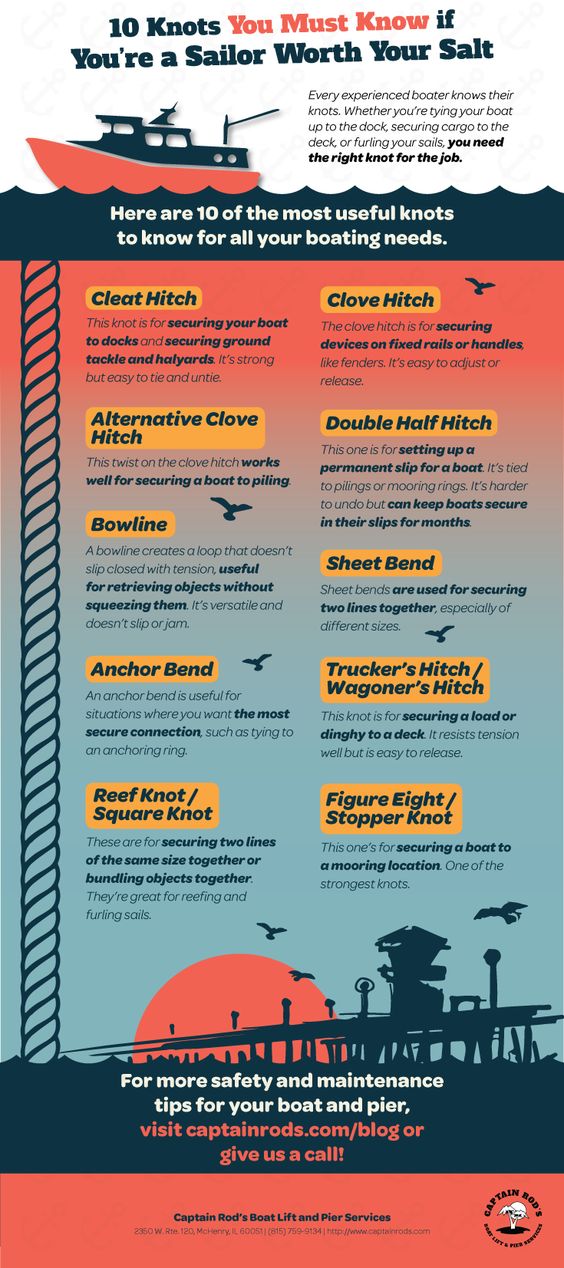Learn Essential Knots for Securing Your Boat to Your Boat Dock, Your Cargo to Your Deck, and More
Every experienced boater knows their knots. Whether you’re tying your boat up to the boat dock, securing cargo to the deck, or furling your sails, you need the right knot for the job. Yet there are so many knots out there to learn—dozens, even. Will you really need them all? What are the essentials you should know to get by?
Captain Rod’s got you covered. Here are 10 of the most useful knots to know for all your boating needs. You can see which ones you want to learn for your boating needs, then find step-by-step animations to learn how to tie each knot.
Once you know how to safely secure your boat to the dock, check out our FAQ for more essential dock and pier know-how!
1. Cleat Hitch
This knot is for securing your boat to a boat dock and securing ground tackle and halyards. Since tying your boat to the boat dock is a pretty important and common task, this is one of the first knots you should learn. This knot requires a cleat to tie the knot around, and is strong but easy to tie and untie.
2. Clove Hitch
The clove hitch is for securing devices on fixed rails or posts, like fenders, bollards, or pilings on a boat dock. It’s easy to adjust or release.
3. Alternative Clove Hitch
This is a twist on the clove hitch that works great for securing a boat to piling. Instead of creating loops by wrapping the line around a fixed bar, you create the loops first and then place them over the piling or other post.
4. Double Half Hitch
This one is for setting up a permanent slip for a boat. You can tie it to pilings or mooring rings. It’s takes more effort undo than a clove hitch does, but that’s why it’s good for securing boats that will be shifting around in their slips for weeks or months at a time.
5. Bowline
A bowline creates a temporary loop that doesn’t slip closed with tension. Since it doesn’t slip or jam, it’s easy to untie when you’re done with it. This knot can be placed over a cleat or piling, or used to attach a line to an eye. It’s also useful for retrieving objects without squeezing them with a loop that slips closed with tension. Remember though that a bowline can come undone when not under load, and isn’t as secure with more slipperier materials like polypropylene.
6. Sheet Bend
Sheet bends are used for securing two lines together, especially of different sizes. It’s easier to untie than a typical reef/square knot as well.
7. Anchor Bend
An anchor bend is useful for situations where you want the most secure connection, such as tying to an anchoring ring. This knot is so secure that you should keep in mind you may need to cut it to release it.
8. Trucker’s Hitch / Wagoner’s Hitch
The trucker’s hitch or wagoner’s hitch is great for several uses. One is tying loads down to the deck. Another is securing a dinghy to the deck during a storm. This knot resists tension well but is easy to release.
9. Reef Knot / Square Knot
These are for securing two together, especially of the same size. Alternatively, you can use it for bundling objects together, making it great for reefing and furling sails. However, while this is one of the simplest knots to tie, it’s also a fairly light-duty knot. On top of that, if you tie it incorrectly, you’ll end up with a granny knot, which is weaker and more difficult to untie.
10.Figure Eight / Stopper Knot
This one’s for securing a boat to a boat dock or other mooring location. This is the type of knot that rock climbers use to hold their gear during a climb, so you know it’s an extremely strong knot.
There’s a lot for a new boater to learn, and these knots are only the beginning. For more safety and maintenance tips for your boat dock in McHenry, IL and the greater Chain O’Lakes region, give Captain Rod’s Boat Lift & Pier Services a call at (815) 759-9134. We’re the go-to experts for installing, maintaining, repairing, or removing a boat lift or boat dock, and we’re always happy to address your boating needs and “show you the ropes”!

